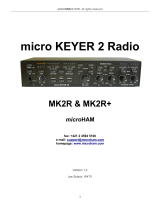
IMPORTANT .............................................................. i
FEATURES ................................................................ i
EXPLICIT DEFINITIONS ........................................... i
SUPPLIED ACCESSORIES ...................................... i
FCC INFORMATION .................................................ii
DISPOSAL .................................................................ii
ABOUT CE AND DOC ...............................................ii
ABOUT SPURIOUS SIGNALS ..................................ii
ABOUT THE TOUCH SCREEN ...............................iii
DTouch operation .............................................. iii
DTouch screen precautions ..............................iii
DTouch screen maintenance ............................iii
VOICE CODING TECHNOLOGY .............................iii
ABOUT THE MANUALS ........................................... iii
TRADEMARKS .........................................................iii
ABOUT THE INSTRUCTIONS .................................iv
KEYBOARD ENTERING AND EDITING .................. v
USABLE CHARACTERS..........................................vi
PRECAUTIONS ........................................................ix
BATTERY CAUTIONS ..............................................xi
DBattery caution ...............................................xi
DCharging caution ...........................................xii
IMPORTANT NOTES ..............................................xii
DWhen using the GPS receiver .......................xii
DElectromagnetic Interference ........................xii
1 INITIAL SETUP........................................ 1-1
Selecting a location .................................. 1-1
Connecting a microphone ........................ 1-1
Attaching the cushions ............................. 1-1
Attaching the Battery pack ....................... 1-1
Charging the battery pack ........................ 1-2
DBattery icon .................................................1-2
DCharging time .............................................. 1-2
DCharging with a USB cable .........................1-2
2 PANEL DESCRIPTION............................ 2-1
Front panel ............................................... 2-1
Bottom panel ............................................ 2-2
Side panels .............................................. 2-3
Speaker Microphone ................................ 2-3
Touch screen display ............................... 2-4
DFUNCTION screen ...................................... 2-6
DMENU screen .............................................. 2-7
DQUICK MENU .............................................2-7
DMulti-function menus ...................................2-7
Multi-function dial ..................................... 2-8
3 BASIC OPERATION ................................ 3-1
When first applying power ........................ 3-1
Selecting the mode .................................. 3-1
Turning power ON or OFF ....................... 3-1
Adjusting the volume level ....................... 3-1
Using the VFO mode ............................... 3-1
DSelecting VFO A or VFO B ..........................3-1
DEqualizing VFO A and VFO B......................3-1
Selecting the operating band ................... 3-2
Selecting the operating mode .................. 3-2
Setting the frequency ............................... 3-3
DUsing the Main Dial .....................................3-3
DAbout the Tuning Step function ...................3-3
DChanging the Tuning Step ...........................3-3
DAbout the 1 Hz step Fine Tuning function ...3-3
DAbout the 1/4 Tuning function......................3-3
DAbout the Auto Tuning Step function ........... 3-3
DDirectly entering a frequency.......................3-4
DBand Edge Beep .........................................3-5
DEntering a Band Edge .................................3-5
Dial Lock function ..................................... 3-8
RF gain and SQL level ............................. 3-8
Meter display ............................................ 3-9
DMeter display selection ................................3-9
DMulti-function meter .....................................3-9
Adjusting the transmit output power ......... 3-9
Setting the maximum transmit power ..... 3-10
Adjusting the microphone gain ............... 3-10
4 RECEIVING AND TRANSMITTING ........ 4-1
Preamplifiers ............................................ 4-1
Attenuator ................................................ 4-1
RIT function .............................................. 4-2
DRIT monitor function ....................................4-2
Monitor function ....................................... 4-2
AGC function control ................................ 4-3
DSelecting the AGC time
constant preset value ..................................4-3
DSetting the AGC time constant ....................4-3
Using the Digital Twin PBT ...................... 4-4
Selecting the IF filter ................................ 4-5
Selecting the IF filter shape ..................... 4-5
Notch Filter ............................................... 4-6
DSelecting the Notch filter type......................4-6
DSetting the Manual Notch filter ....................4-6
Noise Blanker ........................................... 4-7
DAdjusting the NB level and time ..................4-7
Noise Reduction ....................................... 4-8
DAdjusting the Noise Reduction level ............4-8
Setting the transmit filter width ................. 4-8
TABLE OF CONTENTS
vii
BASIC MANUAL

























